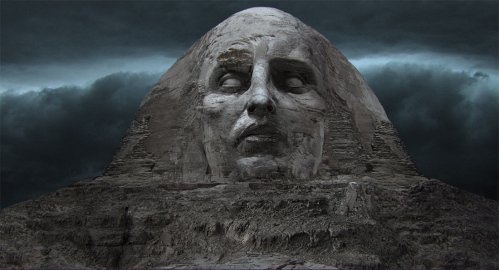
“And on the pedestal these words appear:
‘My name is Ozymandias, King of Kings:
Look on my works, ye mighty, and despair!’
Nothing beside remains. Round the decay
Of that colossal wreck, boundless and bare,
The lone and level sands stretch far away.”
~ Ozymandias, Percy Bysshe Shelley, 1817.
“There are inspirations for Alien,” said Dan O’Bannon in 1979. “I had a lot of second thoughts about Dark Star, that was one of them. Well, another source was that I met Giger when we were working on Dune, and I’d looked at his picture books and when I got back to America I was still haunted by his work. It was on my mind and when we sat down to do Alien. I ended up visualizing the thing as I was writing it, as we were thinking it out and I was writing it. I found myself visualizing it as a Giger painting.”
Giger’s biomechanic style was so pivotal to the look and feel of the Alien, the Space Jockey and his derelict aircraft, that O’Bannon would later state, “without him I don’t think we would have had much of a movie.” Ridley Scott famously stated that upon see Giger’s Necronomicon art book he had “never felt so sure of anything” in his life – Giger had to design Alien. When the producers resisted, Scott threatened to walk. He got his way. Thirty years later with Prometheus, Scott was more reluctant to return to Giger’s signature biomechanical style. “I don’t like to repeat myself,” he stated.
“At first the Giger element was almost inexistent, because we really wanted architecture that looked as if it was Giger stuff but had been ‘kidnapped’, as if we had arrived many thousands of years before, and the Engineers place was clean, spotless.”
~ David Levy, Prometheus concept artist, 2012.
“One of the first things you start to think about when you’re working on a movie like this is, ‘how much are we revisiting that [Giger] look?’” said Prometheus concept artist, Ben Proctor. “I mean clearly if we’re showing the society of these Engineers, which is Ridley’s new take on where that Juggernaut ship came from in the first movie, we’re going to be seeing a lot more Giger, right? And that was our assumption going in, but our geek fan presumptions were not necessarily shared by Ridley and Arthur [Max]. So there were ideas about Engineer architecture and the style of that civilisation that initially were quite far from Giger, much more monolithic and much more heavy and simple and brutal, but in a totally different way.”
Production designer Arthur Max claimed that they “didn’t want to be like any one of those [original Alien designs.] We wanted to be new and fresh because, I hate to admit it, otherwise it really dates us. We decided to make it less biological, in terms of the styling of the alien planet, and more mechanical … The people who inhabit this planet, called the Engineers, and their technology, is beyond anything we’re able to know or understand, but it has to be visually interesting. That’s, I think, the hardest challenge, too, because we have to compete with the most iconic science fiction creature ever. Trying to come up with something that’s going to rival that is the real trick.”
Steven Messing, the film’s visual effects art director, and the other artists tried to shoehorn in Giger’s aesthetic wherever they could, usually bartering with Scott and Max to include more of a Giger influence on the Engineers’ technology and architecture. The artists took everything they had designed thus far and infused it with more of a biomechanic coating than they had included previously.
“I think he [Scott] just didn’t want the Giger style to be necessarily the driving force behind the look,” said David Levy, “there had to be more, something smarter in the terms of what’s the background of those Engineers – and then we infused them with the Giger style.”
As a result the planet no longer resembles LV-426 as it did initially, and the interiors of the derelict craft, now named the Juggernaut, is pristine, almost sterile. Whereas Alien‘s derelict drips and glistens, the new ship is sepulchral but static. The former is the belly of some great dead carcass. The Juggernaut is a piece of machinery awaiting activation.
“The Juggernaut might look like it has come from the same factory as the one in Alien,” Richard Stammers told Cinefex, “but it is not the same ship. The exterior shape is similar, but it has way more detail; and inside it had a little less emphasis on bones and organic shapes than were present in Giger’s work.”
“Ridley was very attached to the biomechanical aspect,” explained prosthetics supervisor, Conor O’Sullivan, “but in Prometheus, the biomechanical details on the walls and ground [of the derelict] are much finer, better defined, because this environment is meant to be in almost mint condition. There is no sign of decay, of rust, nor of translucent slime as in Alien, because time yet hasn’t had its effect.”
The Juggernaut then, is an almost fresh-from-the-factory aerial destroyer. Perhaps in time to come the walls will tumble and reveal bone-like protrusions, ribbing in the walls, and decaying biomechanical innards, as the technology of the Engineers (or of the Space Jockeys as represented in Alien, at least) is a cross between genetics and mechanics.
“In Prometheus,” explained production designer Arthur Max, “this [Engineer] technology is in perfect operating condition, while in Alien you could only see the ruins of it.” Biomechanics, he explains, “is at the root of their culture and technology.”
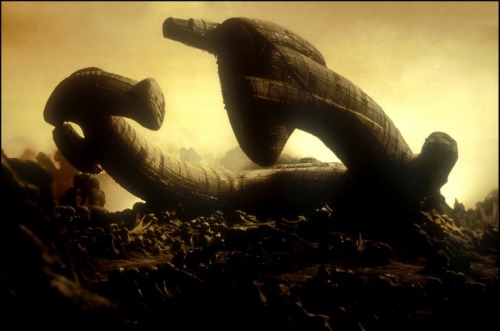
Ridley himself had always kept an idea of the ship’s back story in his mind. “I was amazed that no one asked me about this mysterious element of the film,” he said to French magazine L’Ecran Fantastique, “but if you would have asked me in 1978, I would have gladly explained that, in my mind, all this alien ship could be was a battleship.”
There are traces of biomechanical flourishes throughout the film’s designs. The decapitated Engineer’s helmet was to be like “cracking open an oyster” according to Neil Scanlan, and was sculpted with “castings from organic textures, including cabbages, cauliflower, and lichen. When the helmet opened, Ridley wanted the interior to be velvety and soft like the lining of a stomach, as if the helmet had nurtured the internal head with life-giving material.” One of Spaihts’ early scripts describes the Space Jockey’s suit as being welded to his body, flesh and machinery as one.
The production also chanced upon the work of Russian artist Alex Kozhanov, known as Gutalin, whose ZBrush art pays homage to Giger – some pieces even feature the Alien itself, and others feature the impressions of facehuggers. Steven Messing printed off Gutalin’s work and left it lying on his desk in the hope that Ridley would chance upon it – he did, and Gutalin was hired from afar, working on the textures of the Juggernaut. “Bit by bit with these kinds of sneaky interventions we kind of got some of the Giger back in. When [Ridley] saw something that was clearly Giger-esque, but had a fresh take on it, it piqued his interest.”
For the Engineer temple, or pyramid, the production drew on Giger’s work on Alejandro Jodorowsky’s aborted Dune. For that film Giger had designed the Harkonnen Castle: a mobile fortress made of bone, studded with spikes and surrounded by a storm of dirt, gore and faeces. At the pinnacle of this structure sits a monolithic head.
Initially, the production drew on O’Bannon’s original Alien screenplay, and the Engineer temple was a pyramid in design. In the movie, it is still referred to as a pyramid by the crew, despite being ovoid in shape.
This wasn’t the first time that Giger’s Dune designs found themselves cast as an alien/Space Jockey structure. In several of Scott’s Ridleygrams for the original Alien, the temple/egg silo containing the Alien spore was derived from Giger’s work:
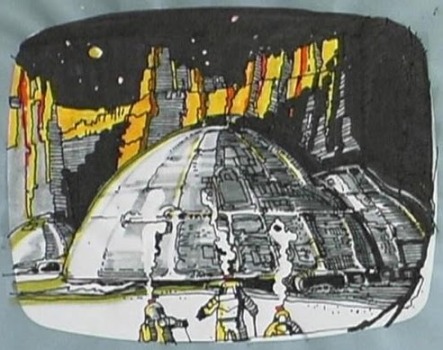
Spherical temples based on Giger’s Dune and Alien conceptual pieces. In the background we can see several other silos passing into the distance, just as they do in Prometheus.
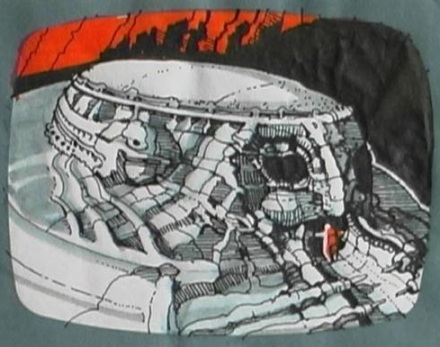
At the summit of these silos sits a dessicated head. Kane was to enter the egg chamber through here.
The interior of the temple in Prometheus is cavernous, rocky and wet. Flowstone walls. We find that it functions as an atmosphere processor, cut into the shape of a near-natural formation. Further inside is the ‘head room’, also known as the ‘ampule room’, where the crew of the Prometheus make the find of the century – the decapitated corpse of an Engineer; the ampules containing their biological weaponry; the monolithic carving of an Engineer’s head; and the murals of this ancient race, adorning the ceiling and far wall.
The murals hint at some history between the Engineers and mutated, deformed beings. The Alien/Ultramorph mural on the far wall hints at the Engineers’ reverence for some supreme being. “The Xenomorph in my mind was the descendant of the Ultramorph,” explained Steven Messing, “in my mind it was the pure form of this kind of virus that the Engineers had created.”
“They’re a lot about sacrifice,” Messing continued, “so in my mind there was [in the past] an Engineer who sacrificed himself to this virus and it created this horrific creature. This being, that was gonna eradicate planets, it was like a parasite that would destroy the planet and then they [the Engineers] could start over and rebirth it. And they kind of worshipped it and you see this relief sculpture where it’s almost a religious sculpture As the virus spread and got polluted the Xenomorph was an evolutionary descendant that was not as pure.”
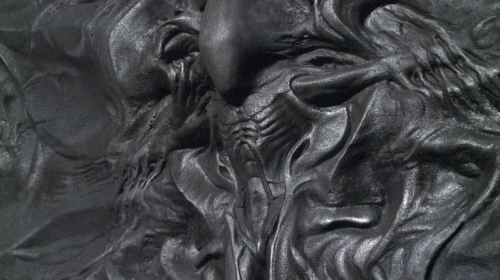
“Another set that I worked on was known as the ‘Head Room.’ This was a ceremonial room that contained hundreds of ampules beneath a giant sculpture of an Engineer’s head. Julian Caldrow did an amazing job of working out all of the details for this environment and created the set drawings. The final set was built at full scale and was incredible to walk on. I also sculpted an altar area for this set that paid homage to Giger – it is a relief sculpture hanging from the wall and has the impression of an alien form with flowing structures surrounding it. There are a lot of easter eggs in this sculpture – including several hidden Giger motifs that were not used in the original film.”
~ Steven Messing, i09.com, 2012.
Essentially, what we can infer is that the Engineers created a life-creating substance that acted as a virus – it could break down and reconstitute matter: living beings are broken down and mutate. An Engineer at some point, somehow, created the first Ultramorph during a sacrificial rite, perhaps like the one we see at the beginning of the movie. The Ultramorph is vicious, and wipes out entire planetary populations. The Engineers, who travel from world-to-world, arbitrarily creating and destroying as they go, come to worship or revere their creation. Somehow, this Ultramorph leads to their eventual demise, or at least the demise of the Engineers inhabiting their installation on LV-223.
One problem with Messing’s interpretation is that the derelict in Alien is eons older than the installations in Prometheus – ergo, the Alien eggs predate the urns, and the Xenomorph predates the Ultramorph. We can probably settle the discrepancy by concluding that the installations on LV-223 are in fact older, but were maintained until only 2000 years ago; the derelict is younger, but has not been maintained for a longer span of time. Later movies may decide the issue.
The monolithic head, once rumoured to be the pilot of the Juggernaut ship, seems to testify some sort of blank, terrible power. Whether it signifies a god, a particular Engineer, or the Engineer race as a whole, we don’t know. “The idea there is that it’s part of the culture of the Engineers,” said Arthur Max, “this race of interplanetary visitors who have given us upgrades –mentally and physically– over the millennium.” The head is inscribed with glyphs on its front and sides. One idea thrown around production was to have the Engineers bearing facial, tribal tattoos. The glyphs on the giant head resemble those on the structure’s walls, doorways and on the deadly ampules.
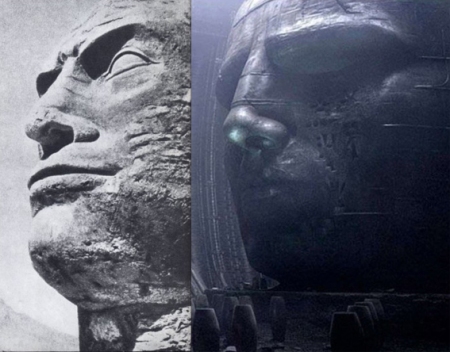
Ethiopian statue of Benito Mussolini, and the Engineers’ ‘God-Head’. Testaments to power and worship. Mussolini was gunned down, hoisted to the girder of a garage, and his corpse pelted, shot, and spat on. As Percy Shelley wrote in his poem Ozymandias, great and terrible leaders die, and the monuments to their reign topple and crumble, left to gaze over a buried empire. The legacy of the Engineers has fared no better
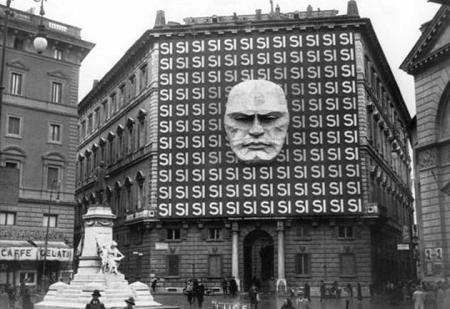
Palazzo Braschi, taken in Rome in 1934. The Engineer head monument is an allusion to worship and power, perhaps even fascistic power.
The lone surviving and hibernating Engineer lies within the depths of the alien earth. Tesselated pathways lead to the pilot’s chamber. The sleeping pods are a new addition to the pilot’s chamber, as is the command seat and the orrery light show. The sarcophagus-like shape of the cryo-pods evoke, somewhat, Giger’s painting known as The Tourist IV, which depicts a strange, sleeping biomechanoid creature in stasis.
The Engineer’s shipmates are all dead – their chests punctured and corpses long ossified. “The dead Engineers decayed where they fell and became part of the environment,” explained Scanlan. Whatever sprouted from their bodies is long gone, perhaps dead, and completely unknown. They may have given birth to a host of Ultramorphs who proceeded to wreak havoc on the installation. The awakened Engineer, freshly roused from his aeonic slumber, strangely has no concerns for this, and proceeds to resume his mission to destroy the Earth before falling victim to the fruits of his peoples labour. A new Ultramorph is thus born.

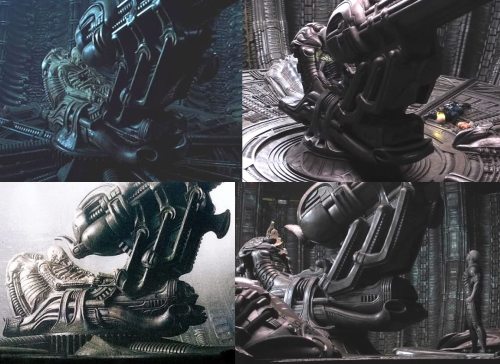

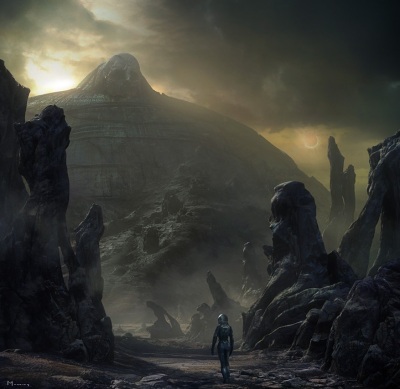
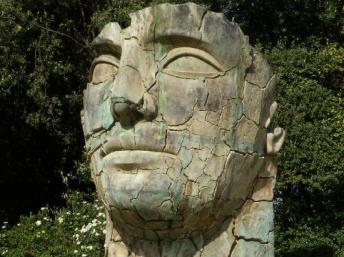


The new site looks great.
I’ve been watching the Prometheus docs from the blu-ray this past week. Are you going to be doing a lot of Prometheus articles in the near future? Maybe a detailed article on the controversial Deacon alien? I’m still not sure if I like that design yet. It was a shock at first, but now I am not as hostile towards it after seeing the film again a few more times.
In the film it is obvious that those urns or ampules become unstable in an uncontrolled climate. These ampules contain biology that is undeniably related to the xenomorph, we see what happens when the DNA spills onto organisms like worms and when it gets inside or on a human. The goo is essentially the spore and it goes back to Dan O’Bannon’s original script where the eggs are initially described as urns with strange markings or jars containing spores. These are the strands of Alien DNA that Ridley spoke of before the film’s release, quite simply, the mural of the Deacon represents the life-cycle the engineers had designed for the human species; a sexually transmitted virus, the resulting creature has none of the biomechanical features of the classic xenomorph. Why? The clue is in the ampule chamber; the ampules are increasingly becoming unstable due to the changing climate, the organic black goo is literally melting through the metal containers and given the the parallels of the arrangements between the ampules in the ampule chamber and the ‘eggs’ in the egg chamber in Alien it is strongly implied that the ‘eggs’ are what these ampules are changing into, over time they will become more organic, with growing facehugger embryos inside. This is why the ampules have to be contained in temperature controlled stasis, why David sprayed coolant on the ampule and stored it in the refrigerator. This completely provides context to what happened to the derelict that crash landed on LV-426; the cargo became unstable. Ridley has always described the Juggernauts as ‘bombers’ thus it makes sense that the ampules were the original artillery and the original bioweapon before it got out of control. Indeed, when Kane descends into the egg silo in Alien he remarks on the temperature being like the tropics and notices the eggs boiling and dripping strange black liquid upwards…In Prometheus, in the ampule chamber, the temperature changes, the urns start to boil and we see black goo melting through the tops of the canisters and dripping upwards, when David touches the goo melting through the metal he remarks, ‘organic’. When the mural changes we see an egg, strongly indicating what the ampules are changing into.
Pingback: Gods & Monsters | Strange Shapes
Pingback: Prometheus-by-Minute 29 – Travian Designs